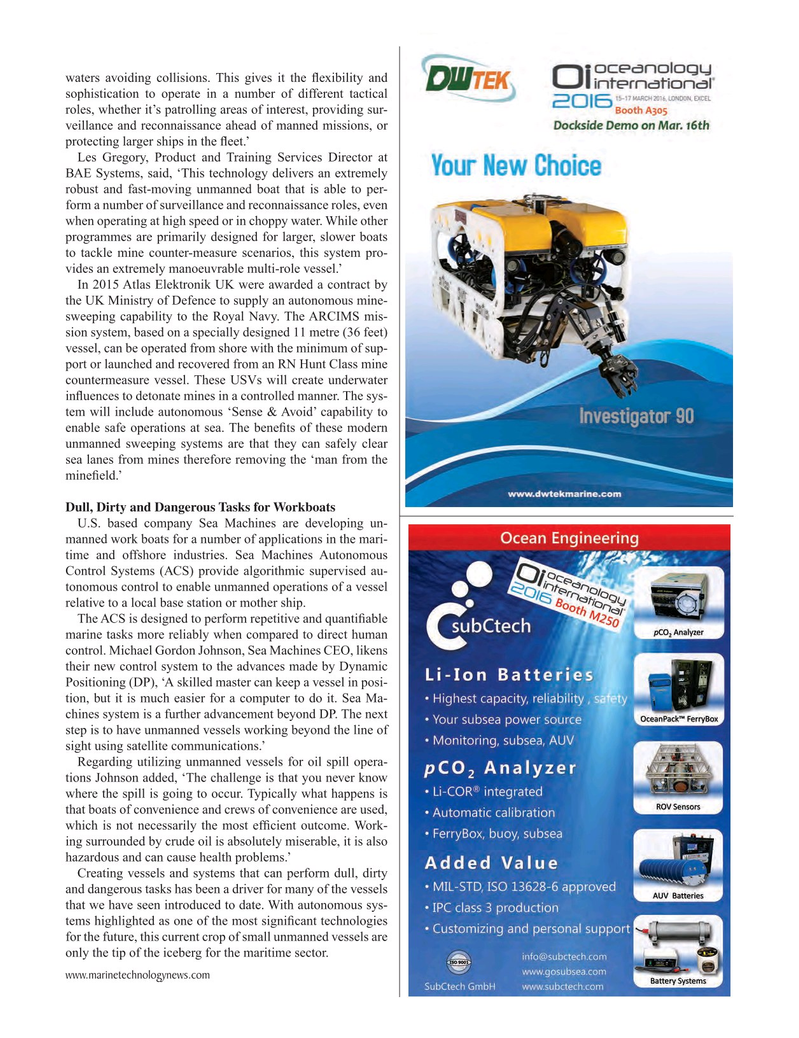
Page 51: of Marine Technology Magazine (March 2016)
Oceanographic Instrumentation: Measurement, Process & Analysis
Read this page in Pdf, Flash or Html5 edition of March 2016 Marine Technology Magazine
waters avoiding collisions. This gives it the ? exibility and sophistication to operate in a number of different tactical roles, whether it’s patrolling areas of interest, providing sur- veillance and reconnaissance ahead of manned missions, or protecting larger ships in the ? eet.’
Les Gregory, Product and Training Services Director at
BAE Systems, said, ‘This technology delivers an extremely robust and fast-moving unmanned boat that is able to per- form a number of surveillance and reconnaissance roles, even when operating at high speed or in choppy water. While other programmes are primarily designed for larger, slower boats to tackle mine counter-measure scenarios, this system pro- vides an extremely manoeuvrable multi-role vessel.’
In 2015 Atlas Elektronik UK were awarded a contract by the UK Ministry of Defence to supply an autonomous mine- sweeping capability to the Royal Navy. The ARCIMS mis- sion system, based on a specially designed 11 metre (36 feet) vessel, can be operated from shore with the minimum of sup- port or launched and recovered from an RN Hunt Class mine countermeasure vessel. These USVs will create underwater in? uences to detonate mines in a controlled manner. The sys- tem will include autonomous ‘Sense & Avoid’ capability to enable safe operations at sea. The bene? ts of these modern unmanned sweeping systems are that they can safely clear sea lanes from mines therefore removing the ‘man from the mine? eld.’
Dull, Dirty and Dangerous Tasks for Workboats
U.S. based company Sea Machines are developing un- manned work boats for a number of applications in the mari- time and offshore industries. Sea Machines Autonomous
Control Systems (ACS) provide algorithmic supervised au- tonomous control to enable unmanned operations of a vessel relative to a local base station or mother ship.
The ACS is designed to perform repetitive and quanti? able marine tasks more reliably when compared to direct human control. Michael Gordon Johnson, Sea Machines CEO, likens their new control system to the advances made by Dynamic
Positioning (DP), ‘A skilled master can keep a vessel in posi- tion, but it is much easier for a computer to do it. Sea Ma- chines system is a further advancement beyond DP. The next step is to have unmanned vessels working beyond the line of sight using satellite communications.’
Regarding utilizing unmanned vessels for oil spill opera- tions Johnson added, ‘The challenge is that you never know where the spill is going to occur. Typically what happens is that boats of convenience and crews of convenience are used, which is not necessarily the most ef? cient outcome. Work- ing surrounded by crude oil is absolutely miserable, it is also hazardous and can cause health problems.’
Creating vessels and systems that can perform dull, dirty and dangerous tasks has been a driver for many of the vessels that we have seen introduced to date. With autonomous sys- tems highlighted as one of the most signi? cant technologies for the future, this current crop of small unmanned vessels are only the tip of the iceberg for the maritime sector.
www.marinetechnologynews.com
MTR #2 (50-65).indd 51 2/22/2016 11:09:03 AM

 50
50

 52
52
